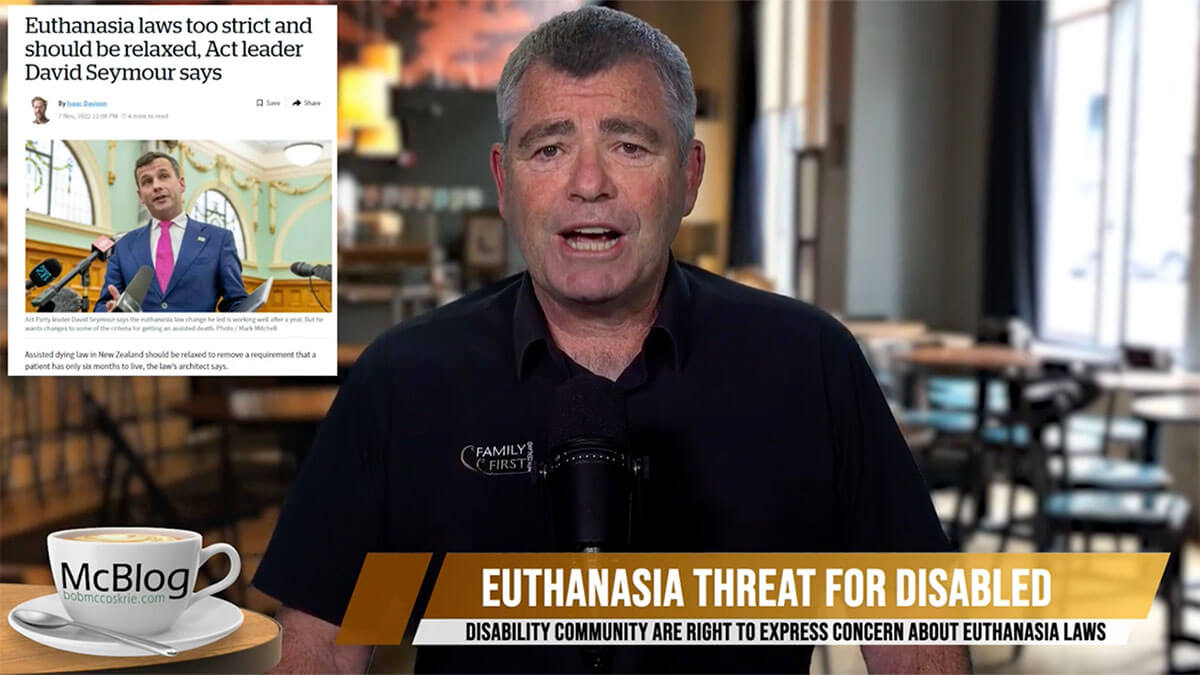
When the euthanasia law was being promoted in New Zealand, disability groups were very concerned about the underlying message it sent. Disability rights groups said, “There are endless ways of telling disabled people time and time again that their life has no value.” So what happens when you combine disability, cost and euthanasia. You only need to look at Canada to see where we may be headed.
TRANSCRIPT:
When the euthanasia law was being promoted in New Zealand, disability groups were very concerned about the underlying message it sent. Disability rights groups said, “There are endless ways of telling disabled people time and time again that their life has no value.” There 2 dangers to the disability community.
Firstly, there are issues with defining terminal and many assume disabled won’t be affected – but what they don’t realise is that many disabilities by their very nature are terminal. Without treatment, they are effectively terminal.
And the 2nd reason is that our assisted suicide law only provides a ‘right’ to one choice – premature death. There is no corresponding right to palliative care. Good palliative care and hospice services are resource intensive; euthanasia would be cheaper. This harsh reality was always the ‘elephant in the room’ in the debate. At an individual level, the economically disadvantaged who don’t have access to better healthcare could feel pressured to end their lives because of the cost factor or because other better choices are not available to them. An overstretched overburdened health system (as NZ currently has) means that cost may play a factor in who is prioritised for treatment.
So what happens when you combine disability and cost. You only need to look at Canada to see where we may be heading.
In a video that has gone viral on TikTok, an Ontario quadriplegic mother of three says she has just days left before she can access medical assistance in dying (MAID) yet she is unable to access disability support.
According to the Canadian federal government’s website, the approval period for MAID is only 90 days. MAID allows individuals with “grievous and irremediable” medical conditions (so not necessarily terminal) to end their life with the assistance of a doctor or nurse practitioner.
Finlay suffered a severe spinal cord injury in her teens and has used a wheelchair ever since. She has always been self-sufficient, she said, but finds herself now needing help and falling ill while waiting to access it.
Here’s the news coverage
VIDEO
Finlay said she was compelled to apply for MAID, not because she wants to die, but because her community is failing her, and she is afraid she is running out of options. Let’s have a watch of her full TikTok video that went viral
VIDEO
Finlay lives in Bowmanville east of Toronto, where she said there is a lack of services for people living with disabilities.
She said “Smaller communities just don’t have the resources available to have proper infrastructure in place for disability services”
She previously lived in Toronto where she said there were resources and programs available but ‘you’ve got to pay higher costs of living to receive them.’
As Finlay continues to count down the days until she can access MAID, she hopes Canadians hear her message about standing together in the fight for access to disability supports.
“Disabled people need able bodied allies amplifying their voices and fighting this fight alongside them.”
Here was her updated video
So the mother of three says it’s easier to access medical assistance in dying than it is to receive disability support services.
The MAID eligibility assessment takes 90 days, it can take up to eight months to receive disability support.
Palliative care is expensive.
Euthanasia is cheap. It’s a frightening scenario. And it’s why the disability community were so vocal against our new law here in NZ.
Dr. Zachary D. Schmoll earned his Ph.D. in Humanities from Faulkner University. He writes:
“As a man with a physical disability, I need a lot of help to perform many basic daily activities. I still consider myself to be an independent thinker, but my physical independence is substantially limited by my severely reduced muscle strength. I need help to drive my van, get dressed, prepare my meals, and complete other daily tasks. For me, this is life. For many others, this level of dependence is motivation to consider bringing life to an end…. The legalization of physician-assisted suicide sends the message that it is better to be dead than disabled. Do I lack dignity because I lack physical independence?
Better Dead Than Disabled
….Society is affirming, by legalizing physician-assisted suicide, that it is better to be dead than disabled. It is better to be in the grave than to live with reduced independence. This message is sent both to people with disabilities like me and everyone else who interacts with us.
Naturally, this is a terrifying step for people like me. By legalizing physician-assisted suicide, our political leaders are saying that if they ever have to live life like mine, they want the opportunity to end it all. They want the ability to “die with dignity.” This raises serious questions as to how they perceive my life. Am I not living with dignity because I lack some physical independence? Is there an inevitable link between dignity and physical strength? Advocates of physician-assisted suicide seem to think so.”
The architect of New Zealand’s law ACT leader David Seymour has already said that the law should be relaxed to remove a requirement that a patient has only six months to live, and that he only agreed to the 6 month requirement because that got the law through.
It’s what you call “getting your foot in the door” And now he wants the door wide open.
And the disability community are right to be concerned – as we all should be.
We must protect our most vulnerable.


